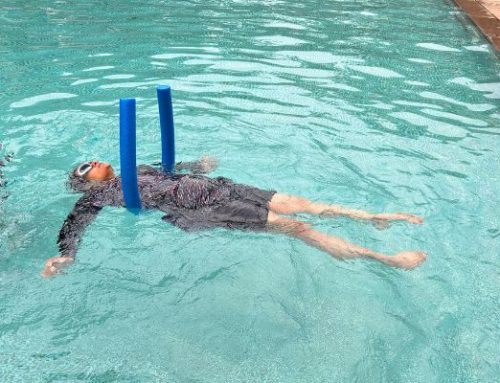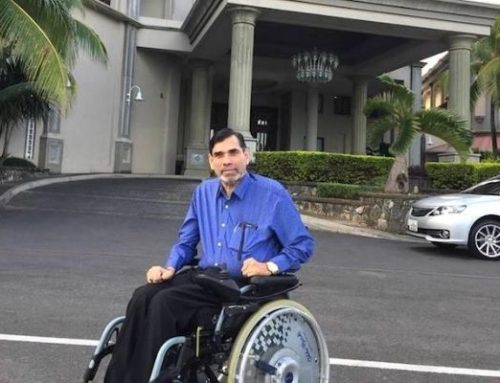“Gadgets I use – handy tech for quadriplegics”
A lot of times I wonder how life would have been without all the tech around us. In my case – it’s assistive-technology. Paralysed below the shoulders with no finger movement in the hands, I am extremely thankful for all the tech and gadgets which help me out in life. They don’t just make me more independent but also helped me in regaining confidence after my introduction to quadriplegia.
Here’s a list of gadgets that I use regularly:
Motorised wheelchair – Ottobock Z50
The first wheelchair that I got during my rehab was a manual one. It was difficult for me to propel because my shoulders were not strong. We used to wrap cycle tire tubes around it’s push-rim to help me get a grip. But I still could not propel it with ease and had to depend on someone else to move me around. It was no fun!
It’s an incredible feeling to be able to move around according to one’s wish. That exactly what a motorised wheelchair did for me. It took me many months to decide which model to choose and I finally zeroed down on Ottobock Z50. These are powered wheels fitted on a Ottobock Motus wheelchair.

- It is one of the lightest motorised chair in market => can be lifted over a couple of steps.
- It is foldable => fits inside the trunk/ boot of a sedan car.
- It is portable => an ideal companion for my travels.
The Z50 totally suits my needs.
Laptop – MacBook Pro
I don’t need to harp on the benefits of a portable computer. In addition to doing office work, I use it to create my blogs and editing videos. The reason I love my MacBook Pro is because of its accessibility features.

- The keys on the keyboard are evenly spaced. Each time I hit the keys with sides of my little finger, on both hands, only one key gets pressed.
- The multifaceted trackpad. It has two finger scrolling. I have also changed the settings from requiring a hard press to just a tap for clicking. The trackpad is very much like a touchscreen.
- Accessibility settings. Sticky keys help in situations which require using two or three keys at once. For example, typing symbols above the numbers and taking screenshots of select portions of the screen.
- Other features such as the inbuilt dictation app also comes handy when the regular dictation software is not available.
Smartphones – Apple iPhone and Samsung Galaxy
It is truly a blessing that we live in a time where we have access to touch phones and internet on our smartphones. My smartphone was the first device that helped me immensely when getting back to work after the injury – I could access emails, write notes, make calls, send messages and so on. Although I’m not able to use my fingers, I can operate the smartphone with my right-hand thumb, using shoulder and wrist control.

Here are my favourite features:
- Accessibility shortcut button on the iPhone. It floats on the screen and can be used for a number of functions, from going to the home screen to taking a screenshot to putting the phone on silent and so on.
- Voice dictation available on Apple iPhone and Samsung Galaxy. It’s a relief to see your thoughts and words transcribed verbatim on the phone, no need to exert the hand with typing. I find the dictation on Android to be better than iOS- it recognises all punctuation marks and gives a smoother experience when typing.
- Front button to switch on the phone. While the latest models of iPhone and Galaxy series flaunt a full-screen display, I’m a big fan of the previous versions which have a front button on the phone to switch-on the handset. Is difficult for me to press the button on the right inside of the screen.
Headphones – Plantronics BlackWire C710
A good noise-cancellation microphone is essential for smooth dictation. Of all the different headsets I have used wired and Bluetooth, I find the Plantronics BlackWire C710-M USB headset to be the best. You can speak at a normal conversation volume and it will capture your audio beautifully. The BlackWire C710 comes with a single ear pad, this makes it easy for me to slide it around my neck when using. The C720 comes with dual ear pads. Since I use it for long durations, I don’t like to fix the headset on my ears and place it on my neck instead.

I also find it difficult to hold regular earphones that we usually use with our smartphones. Lifting them and placing them inside the ear is almost impossible. I use a mid-range Sennheiser over-the-ear headphone for listening to music and my audiobooks. In addition to providing a great audio, it also stays in place when I am moving around propelling the wheelchair in the evenings.
 The gadget that I wear the most is my Bluetooth headphone – Plantronics Explorer. If you look at buying a headphone, you will come across most options that have gel/ silicone in-ear pads. These are also difficult for me to sustain because they keep falling off. The Plantronics Explorer comes with an ear loop that keeps it in place and I love it for that.
The gadget that I wear the most is my Bluetooth headphone – Plantronics Explorer. If you look at buying a headphone, you will come across most options that have gel/ silicone in-ear pads. These are also difficult for me to sustain because they keep falling off. The Plantronics Explorer comes with an ear loop that keeps it in place and I love it for that.
Voice-enabled smart speaker – Amazon Echo
Echo Plus is the newest entrant in my gadget collection. It sits on a desk in my bedroom and patiently waits for my voice commands. It is powered by Alexa, a cloud-based voice service to play music, make calls, check weather and news, set alarms, control smart home devices, and much more. It is a joy to see her respond to my voice every time I call out ‘Alexa’.

The top three reasons I use it every single day are:
- Catching up on the news. I just have to say “Alexa, what’s my flash briefing” to catch up on the latest happenings from around the country, tech industry and even Bollywood. Listening to the news on Echo, while brushing my teeth, has become a habit for me in the morning.
- Enjoying music. Just say “Alexa, play songs from my library”, or specify a movie, singer or the name of the song you want to listen to and voila! It has countless songs ready to be played at your wish. Playing songs on the Echo has become a part of my routine during the evening exercises. My helper also enjoys asking Alexa to play her favourite tunes.
- Setting up reminders. My smartphone is not always handy to make a note of things to do and random things I remember randomly. Alexa is perfect at making a note of those and giving me reminders.
I also use it to read my Kindle books, getting answers and having fun with my four-year-old nephew. He comes up with hilarious requests. And when I miss him, I play his favourite rhyme by saying “Alexa, play Machli jal ki rani hai” 🙂
At Amazon, I work closely with the Echo/ Alexa team and it’s definitely an advantage because I am one of the first ones to get to know new features as they are launched. It’s magical to use a device that responds to just your voice – no holding, tapping or swyping required.
If you also have a disability, then do share the names of devices that bring a relief to your life. I’m keen to explore more.




